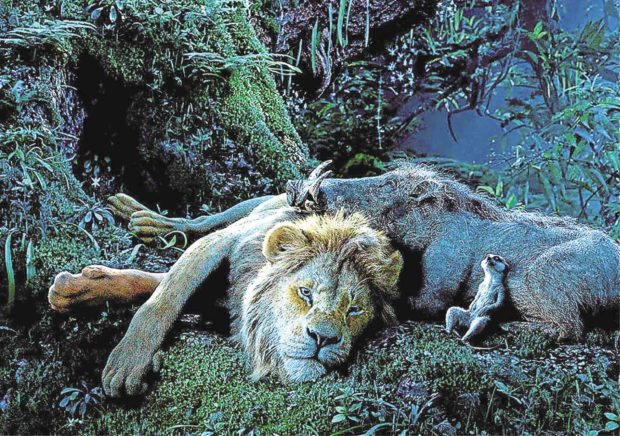
Simba (voiced by Donald Glover), Pumbaa (Seth Rogen) and Timon (Billy Eichner) in the live-action adaptation of Disney’s “The Lion King”
Disney’s “The Lion King” film is a “live action” remake of Disney’s animated film of the same name. It’s the most recent of Disney’s live action remakes of their animated films, following other properties such as “Cinderella,” “Beauty & the Beast,” “Dumbo,” and “The Jungle Book” (which “Lion King” director Jon Favreau previously directed).
What immediately sets “The Lion King” apart from those remakes is that it’s Disney’s first live action remake that doesn’t even attempt to update or revitalize the original film.
All the prior remakes have included revised or additional scenes and story elements that addressed criticisms of their now simplistic animated counterparts; the “Aladdin” remake gave heroine Jasmine more agency, “Cinderella” and “Beauty & the Beast” gave their protagonists backstories, and Maleficent made the infamous villain more sympathetic. “The Lion King” doesn’t remotely attempt this.
A welcome revision is that the remake incorporates more traditional African music, which the Broadway musical does exceptionally. Additionally, James Earl Jones returns from the original film to voice Mufasa, but surprisingly, he joins John Kani as Rafiki as the only voice actors who seem interested in reinterpreting their roles.
Everyone else seems more focused on merely recapturing the exact same energy of the original’s characters. Then again, this is a remake of the most popular film of Disney’s most successful era in animation, so recapturing the magic in live action seems to be sole direction of the project.
Ironically, the “live action” animation style the film is going for makes this version of “The Lion King” less dynamic.
Limited palette
It maintains a naturalistic approach, opting to forego the vibrant colors and sweeping visuals of the original epic. While definitely its own separate creative choice, the naturalistic approach puts limitations on what could have been a larger-than-life movie musical. This film’s palette is unfortunately limited to lush green plant life, barren deserts, and the sky at different times of day, so the filmmakers don’t get the same opportunities to play with color.
The filmmakers also limit themselves to shots that seem like an actual camera was physically present to shoot the scene. This is undoubtedly to help sell the film’s live action features, but it doesn’t give audiences a wide variety of visuals to consume.
These limitations lessen the emotional impact of the characters’ journeys, and the performances are almost completely dependent on the voice acting. An animal’s natural expressions aren’t as engrossing as a cartoon’s. The expressions of cartoon animals are heightened, but they’re needed to convey the story. It’s more difficult to empathize with a lion with a limited range of facial movements.
Some scenes, such as Mufasa’s death scene, fall flat due to this. More importantly, characterization is lost along the way. Scar turns into an unengaging British antagonist because the muted expressions take away his flamboyance. Adult Simba’s choice to return to Pride Rock isn’t as meaningful, because he isn’t given the free spirit and laid-back look that shows how difficultit is for him to choose to return.
This hurts the musical numbers most of all. It’s challenging to incorporate rhythm and choreography with photorealistic animals, so the numbers mostly consist of the animals just running around while singing. The is apparent early on from the biggest musical number of the film, “I Just Can’t Wait to be King,” which trades the striking colors of the original number for a muted color pallete, and literally reaches its climax on a small rock in a puddle of water.
While astounding visual effects, the stylistic choice to ground the film in reality is definitely in conflict with the tone of story. “The Lion King” has always been a heightened theatrical story, so taking away fundamental aspects such as color and big performance is counterintuitive to recapturing the magic.
A remake of “The Lion King” could’ve been a fascinating creative endeavor, especially given a likely longer run time, but as it stands, it’s disappointingly just an adaptation stripped down to it’s fundamental narrative elements, without any of the style that made the original animated film a visual feast to begin with.
Rating – 4/10